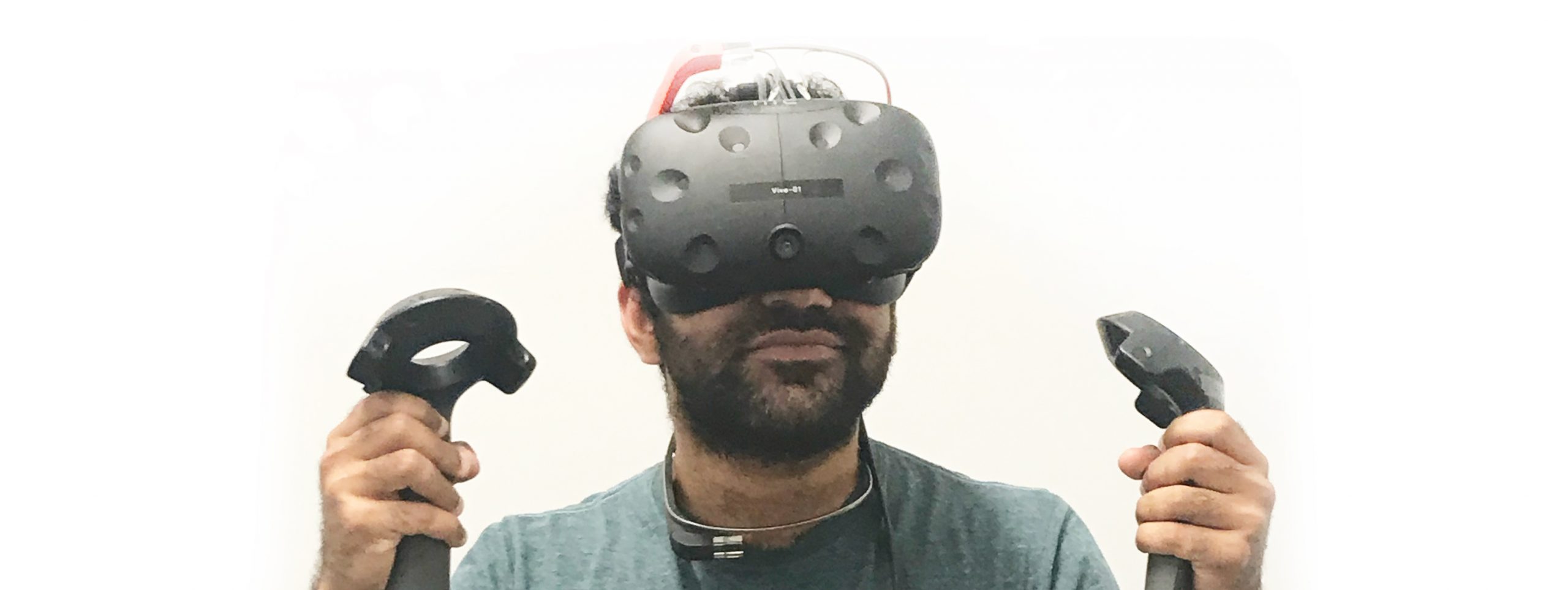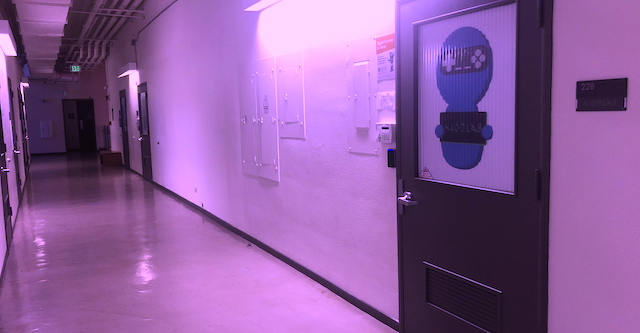What is a laboratory? According to the esteemed molecular biologist François Jacob, it is “a system for concocting expectation; a machine for making the future.”[1] Through the interwoven practices of experimentation, observation, and speculation inside the laboratory, something new emerges: a new discovery, a new invention, a new way of seeing things. The laboratory is an engine for the production of novelty. For howsoever long it continues to generate surprises, affording unfamiliar, exciting, even strange insights, it keeps its promise to open the horizons of expectation and unbind the present. However, if the laboratory manages to produce only common knowledge, regurgitating clichés and textbook facts, then its future-making capacities have crashed; it has become merely a machine for reproducing the status quo—one institutional apparatus among others—and, really, not much of a laboratory at all. But to whatever extent it is a place where unprecedented things can take place, allowing for a play of differences and potentialities, the laboratory helps to draw and redraw the shape of things to come.[2] No matter how small, local, or specialized a laboratory may be, by bringing the messy complexities of the outside—nature, society, consensus reality—inside its circumscribed domain and creating the conditions for variations to emerge, it makes novelty legible, imaginable, and actionable. It’s the whole point, the dream of any laboratory: there are more things in heaven and earth, after all. This is why a laboratory, even by making what Shakespeare’s Horatio might call a “mote” of difference to a particular scientific field or domain of knowledge, also has the potential to change the whole world.[3]
The promise of the yet-unknown future is, of course, fundamental to the shared mythology of modern scientific laboratories. Laboratories model, hypothesize, engineer, and unleash the future in even the most mundane and quotidian experimental procedures, which are precisely designed for isolating, capturing, and rendering inscrutable mysteries at the fleeting moments of their appearance—even if only retrospectively, through analysis of whatever traces they may leave behind as data, the record of what remains to be known. Yet, despite the extent to which laboratories promote themselves as machines for making the future, this is not a future that comes out of nowhere—out of “thin air,” as it were.[4] Instead, laboratories make the future by modifying the elements at hand, the resources of yesterday’s tomorrows: the results of previous experiments, inherited paradigms, hypotheses tested and untested, and an archive of cultural patterns, narratives, and hopeful extrapolations.[5] The future created in the laboratory, in other words, is never purely original, never entirely unprecedented or unanticipated. Rather, it is a tissue of quotations, a bricolage of recycled stuff, modified for the purposes and needs of the immediate present.[6]
The ModLab at the University of California, Davis, was founded in 2008 to study the processes of modification at work in high-tech laboratories, the practices of tinkering, remixing, tweaking, hacking, sampling, and modding at the heart of experimental knowledge. We came together as a group of faculty and students from wildly different disciplines: science and technology studies, literary studies, media studies, computer science, biochemistry, cultural studies, anthropology, philosophy, physics, geology, communications, performance studies, and sociology. Despite differences of training and background, we shared an interest in the day-to-day activities of laboratories and how they forge the conditions for speculative imagining, for thinking otherwise. More specifically, what brought us together to create the ModLab was an intuition that the everyday practices of laboratories—experimental, opportunistic, tactical, improvisational—closely resemble those from two other domains of culture: theater on the one hand, and games on the other. We ventured that these seemingly incongruous domains of practice—science, theater, and games—are actually united, bonded by a common element. Namely, the element of play.
To contend that play is a way of producing knowledge would perhaps seem to contrast with the ideals of the scientific method: the rigorous, stepwise protocols of controlled experimentation, disciplined observation, and inductive reasoning.[7] Yet the basic work of experimentation involves and, indeed, requires a certain degree of capriciousness and exploratory tinkering. The work of scientific labs involves manipulating, preparing, and testing the affordances of samples and instruments, assessing the viability of assay procedures through trial and error, and so forth: toying with the objects, tools, instruments, and models that make up the material culture of the laboratory.[8] Moreover, experiments take place not merely in the physical space of the lab as delineated by its walls and other architectural features, but also, crucially, in the imaginary space superimposed on it, the fabular zone of hypothesis and speculation, born from the question of “what if?” and sustained by efforts to take that question seriously enough to rearrange apparatuses, practices, and professional ambitions—at least for a while. Which is to say, the work of laboratory experimentation requires playacting: a temporary dwelling in consensual fiction, a willing suspension of disbelief, a game of pretend. As François Jacob wrote of his own experiences in the Pasteur Institute in Paris—and especially his work with Jacques Monod and André Lwoff on the regulation of genetic transcription that led to their Nobel Prize in 1965: “The game was that of continually inventing a possible world, or a piece of a possible world, and then comparing it with the real world.”[9]
For Jacob, the scientific laboratory was also—and without any contradiction—a kind of playhouse: a fitting environment for games, puzzles, and daydreams, a place where the real world might be momentarily set aside in favor of speculative, extrapolative, and sometimes even counterfactual fabulations. In this regard, laboratories are like innumerable other domains of culture that thrive on the element of play. According to the historian Johan Huizinga, play is characterized by “a stepping out of ‘real’ life into a temporary sphere of activity with a disposition all of its own.” Play conjures forth other spaces “within which special rules obtain. All are temporary worlds within the ordinary world, dedicated to the performance of an act apart.”[10] Like a game, a sporting event, or a theatrical production, scientific experimentation works in part by casting an invented space, a possible world, that solicits comparison with the real world. But how it does so entails a particular configuration of technical resources and practices whose purpose is ultimately to make the invented world converge completely with the details of the real world, leaving no remainder—leaving “not a rack behind.”[11] In the process, the possible world forged in the laboratory imaginary either gets banished to the domain of fiction, discarded as a failed hypothesis, or instead it becomes an anticipation, a trace of what will have been—a proleptic outpost of things to come. The ordinary world then plays catch-up. As Jacob recalled of his life inside the laboratory, “I found myself in an unfamiliar universe of limitless imagination . . . I lived in the future. I always waited for the result of tomorrow.”[12] Through the game of science, some imaginary conceit that at first appears entirely fictional may prove to be, retroactively, the stuff of actual reality.
This is how any laboratory makes the future: a dance of make-believe and reality checks. A proper laboratory enables researchers to play in a world apart—a fabulous, speculative world animated by the resources on site—and then test its features against the rules and conditions of consensus reality, sometimes modifying consensus reality along the way. Play turns out to be intrinsic, not extrinsic, to the so-called scientific method and the future-making capacities of laboratories.
“To vie strange forms with fancy” | Modalities of Play
Based on the presumption that labs thrive on play, our research in the ModLab has focused on three modalities of play: material play, textual play, and performative play. We designed Play the Knave and other critical media projects to spotlight these three modalities of laboratory play, as well as their overlaps and interrelations.

To conduct experiments, laboratories rely on material resources. Scientists collect samples and prepare specimens, they synthesize and fabricate objects of scientific curiosity, and then they fiddle with them, take them apart, piece them back together, place them into new compositions, and put them on display.[13] They construct models—molecular models, model organisms, computational models—and manipulate them, mold them, and share them with friends.[14] They build, buy, or borrow instruments, detectors, and recording apparatuses, and then they tinker with them to suit the tasks at hand.[15] In this light, the laboratory resembles a playground filled with high-tech toys—a resemblance underscored by the fact that so many scientific instruments and models have also become devices of public entertainment, mass-produced for the recreational enjoyment of hobbyists and children.[16]
To make experiments legible, laboratories rely on textual resources. Indeed, it is easy to imagine that the entire purpose of a scientific laboratory is to transform nature into texts.[17] Inside the laboratory, samples and specimens are processed by instruments that produce marks, lines, symbols, numbers, and other inscriptions.[18] Scientists make notes in their lab books and laptops, scribble formulas on chalkboards and whiteboards, draw graphs, sketch diagrams, doodle flowcharts, and so forth. These various forms of laboratory writing, durable and mobile signifiers, can be further manipulated and modified after the fact. Discoveries may emerge on paper alone, through rearranging symbolic elements, tinkering with diagrams, or reassessing data records.[19] Inscriptions beget more inscriptions, contextualized and interpreted in relation not only to other scientific texts but also to other cultural narratives and generic tropes.[20] Experimental results are repackaged in other discursive formats, turned into conference talks and journal articles, modulated in the processes of peer review and editorial intervention, and ideally disseminated far and wide, beyond the walls of the laboratory.[21] Yet even outside the laboratory, the textual play continues. As scientific texts circulate, other scientists, journalists, and public audiences engage with them, and their fates are determined by the rhetorical modalities of citations and paraphrases. Sometimes the claims get amplified through positive modalities that push them toward the status of “fact.” Sometimes the claims get diminished or discredited through negative modalities that push them toward the status of “fiction.” Nature only appears at the end of the process: nature is the result, not the origin, of all the textual play and rhetorical modification.[22]
To conduct experiments and render their outcomes in discursive formats, laboratories rely on performative resources. The steps for running an experiment—from building and setting up instruments, to gathering and preparing samples, to producing and recording data, to iterating the conditions for the successful display of phenomena, and so forth—usually cannot be gleaned in their entirety simply by reading textbooks, journal articles, or instruction manuals. Scientists must learn how to make experiments work by doing them, repeatedly, and rehearsing key techniques through imitation of other scientists. The work of experimentation relies on what the chemist and philosopher Michael Polanyi called “tacit knowledge”—knowledge that is embodied, habituated, grounded in repetitions of action and affect, and that cannot easily be communicated in symbolic, textual, or verbal fashion.[23] Indeed, successful replication of experimental techniques often depends on practicing them with an already skilled partner, following the lead of someone else who has learned the steps before.[24] Moreover, in the laboratory, experimental insights frequently emerge from bodily movement and improvisation. In the course of getting a feel for instruments, developing the right touch for preparing materials, and running assays, scientists often begin to imaginatively, proprioceptively inhabit the dollhouse worlds conjured in the lab, intuiting their properties and affordances by trying different roles: dancing with molecules, performing with photons, harmonizing with gravitational waves, cosplaying with atoms, ventriloquizing with viruses, or treading the boards of the microscope stage.[25]
Making the results of these embodied research practices legible outside the laboratory often involves not only peer-reviewed publications but also live demonstrations, technological spectacles, and media displays—to say nothing of the actual theatrical plays and cinematic fictions that help to propagate scientific concepts, address social implications, or grapple with the dilemmas of particular scientific communities.[26] The profession of science and the stages of professionalization in any specific discipline—learning to speak, learning to behave as a scientist both inside and outside the lab—likewise require self-reinforcing public performances, including recitations of the canonical scripts and scriptures of the discipline, reenactments of the legends and lore of the lab group, and dramatized debates to establish expert authority and the aura of scientific consensus.[27] Doing science entails a fair amount of stagecraft and showmanship.
Yet these performative dimensions of scientific knowledge-making are often obscured by the textual play of the laboratory and the rhetorical conventions of scientific discourse, which typically subsume the embodied practices of the lab into the grammatical form of the passive voice, the actorless language of research articles and textbooks.[28] These conventions have tended to fictionalize actual research by stripping scientists of their flesh and presenting them as pure brains, pure cogito—as if the messy work of science could take place in the discorporate mind alone, transcending the particular, situated performances that make experimental knowledge possible in the first place.[29] To say the least, there’s a lot more going on behind the scenes.
After all, the performative dimensions of science involve not merely human actors—the scientists, engineers, inventors, science writers, policy makers, and high-tech entrepreneurs who make up the principal cast—but also a motley backstage crew of nonhuman entities, animate and inanimate, living and nonliving. The field of science and technology studies has shown time and again how scientific knowledge and technical innovation emerge from dynamic assemblages of humans and nonhumans, interacting in shared material-semiotic networks that resemble creative performances. For example, Bruno Latour has highlighted the indebtedness of actor-network theory to the theater and its traditions:
An ‘actor’ in the hyphenated expression actor-network is not the source of an action but the moving target of a vast array of entities swarming around it. . . . It is not by accident that this expression, like that of ‘person,’ comes from the stage. Far from indicating a pure and unproblematic source of action, they both lead to puzzles as old as the institution of theater itself. . . . To use the word ‘actor’ means that it’s never clear who and what is acting when we act since an actor on stage is never alone in acting.[30]
With similar attentiveness to questions of performativity and collaborative action, Andrew Pickering has described the humans and nonhumans in the laboratory as engaged in a waltz of resistance and accommodation, a “dance of agency.”[31] Karen Barad has gone further to argue that making meaningful distinctions between human and nonhuman actors, apparatuses and phenomena, theories and observations—cutting reality into discrete parts—is the result, not the precondition, of intra-actions among heterogeneous material agencies: “an ongoing performance of the world in its differential dance of intelligibility and unintelligibility.”[32]
When the ensemble cast of human and nonhuman actors come together in the laboratory, it creates a field of constraints and affordances. The work of knowledge production may sometimes resemble goofing off and messing about, propelled by imaginative visions and speculative fictions—but it is also guided by scientific precedents, established facts, technical limitations, theoretical constructs, and material resistances.[33] It proceeds by rehearsing established scripts, assuming certain shared rules—but modifying or improvising them, often on the fly. The cast of human and nonhuman actors creates its own conditions for transformative movement within constraints, which likewise encourages experimental attempts to surpass such constraints—breaking the rules, making new rules—in order to discover the contours of the possible.[34]
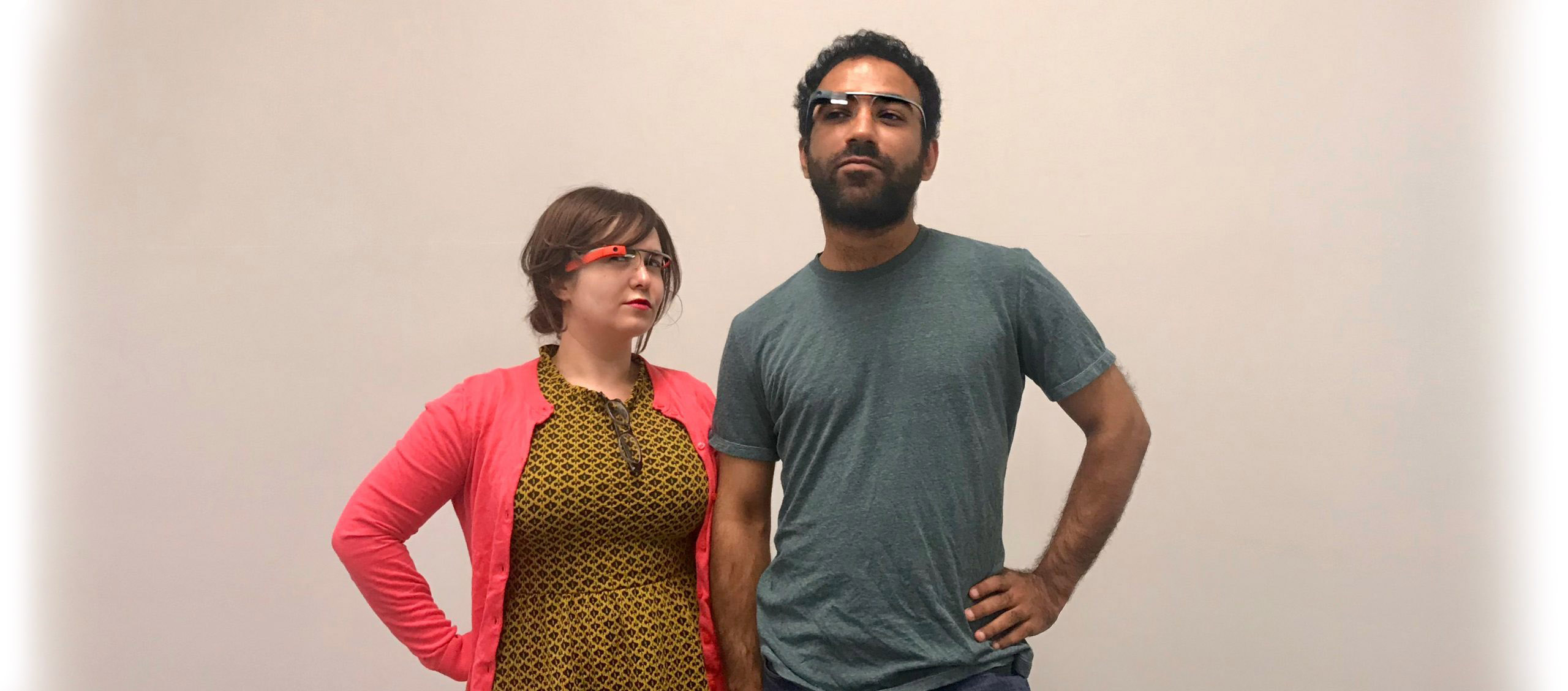
“A crew of patches, rude mechanicals” | Media Operations and Development
We created the ModLab to address these issues—how knowledge is made through play and performance, through fun and games—not only critically and from a distance, but also experimentally and in the middle of the action: making, thinking, and doing. Most of the studies and experiments in the ModLab have aimed to highlight the practices of play, speculation, and modification at the heart of experimental research, the reconfiguring of material, textual, and performative resources to make new futures out of older ones.

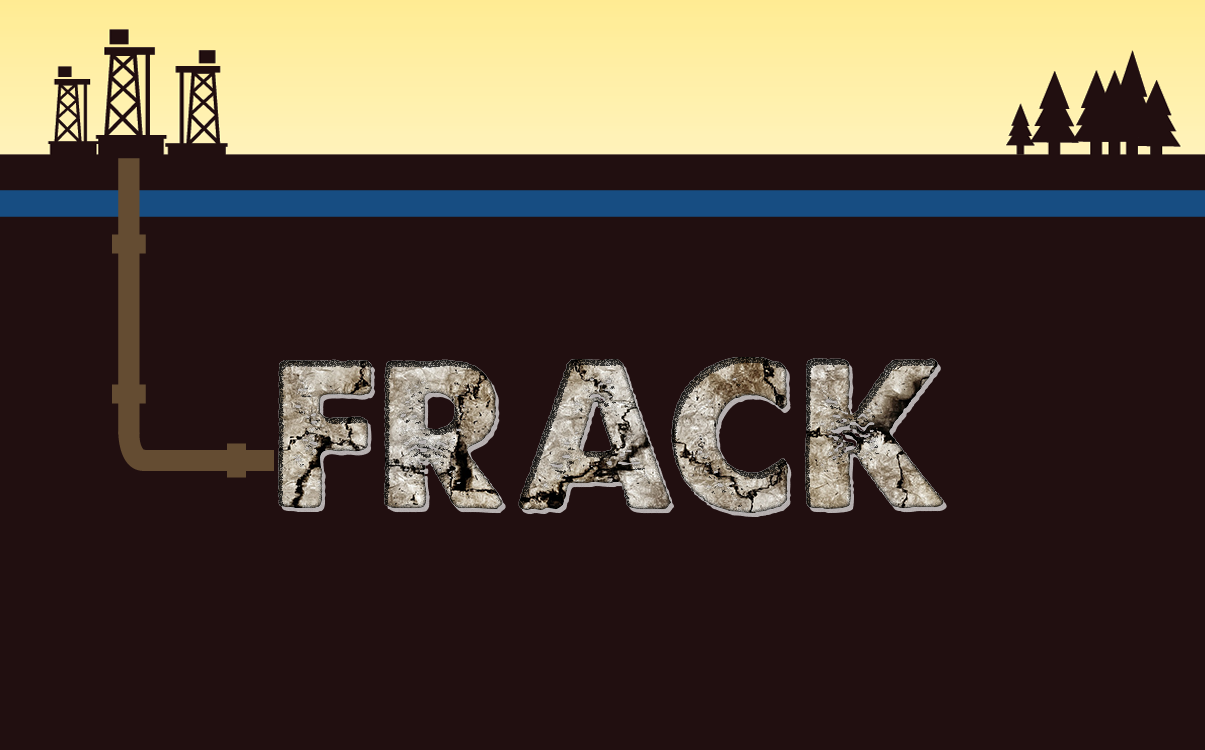
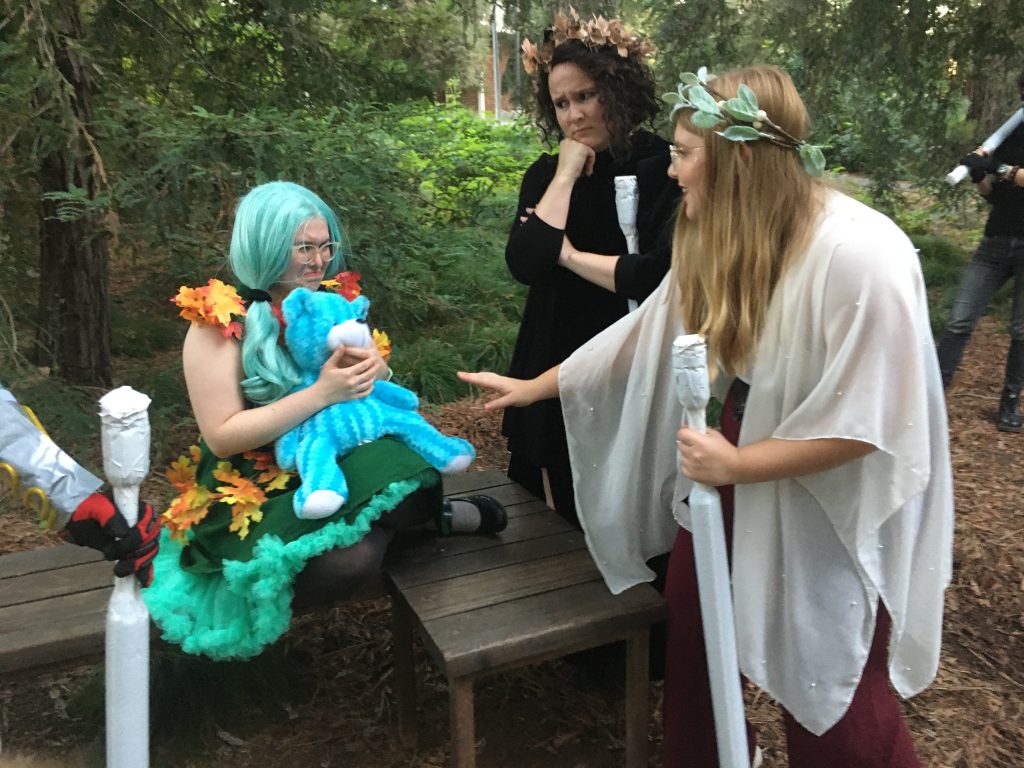
For example, some of our work has examined how scientific practices and scientific discourses draw creatively on science fiction and popular mythologies.[35] Other projects have addressed the value of video games for citizen science and for deepening public engagement with the social and ethical dimensions of new technologies.[36] Some projects have studied how video games become tools for activists, hackers, and trolls of various stripes, used as devices of technopolitics.[37] Other projects have scrutinized the valorization of childish creativity and geek culture in the immaterial labor practices of the high-tech digital economy.[38] Some projects have considered the relationship of theater and technoscience, for example, documenting the significance of mathematical and algorithmic forms in the plays of Samuel Beckett—or, on the flip side, remixing Beckett’s work for mixed-reality performances.[39] Other projects have examined the theatrical tropes of escape rooms—and some members of our ModLab have ventured into the escape room industry.[40] Some projects have studied the ways in which digital interfaces, data surveillance, and pervasive computerization transform embodied experience and recode human subjectivity.[41] Other projects have addressed how games configure cultural logics of gender and sexuality through relational interactions, not only between in-game characters but also between players and game apparatuses.[42] Some projects have examined how games and playable media can activate alternative temporalities, heterochronicities, and the historical imagination.[43] Other projects have studied how practices of game development—inventing, critiquing, and negotiating rulesets for digital games, board games, and live action role-playing games (LARPs)—can also be tools for exploring technoscientific systems, the relations of science and society, and the conditions of social justice.[44] These various and sundry projects in our ModLab portfolio represent the vibrant intellectual context for the work that perhaps best epitomizes our collective efforts, to wit, Play the Knave.
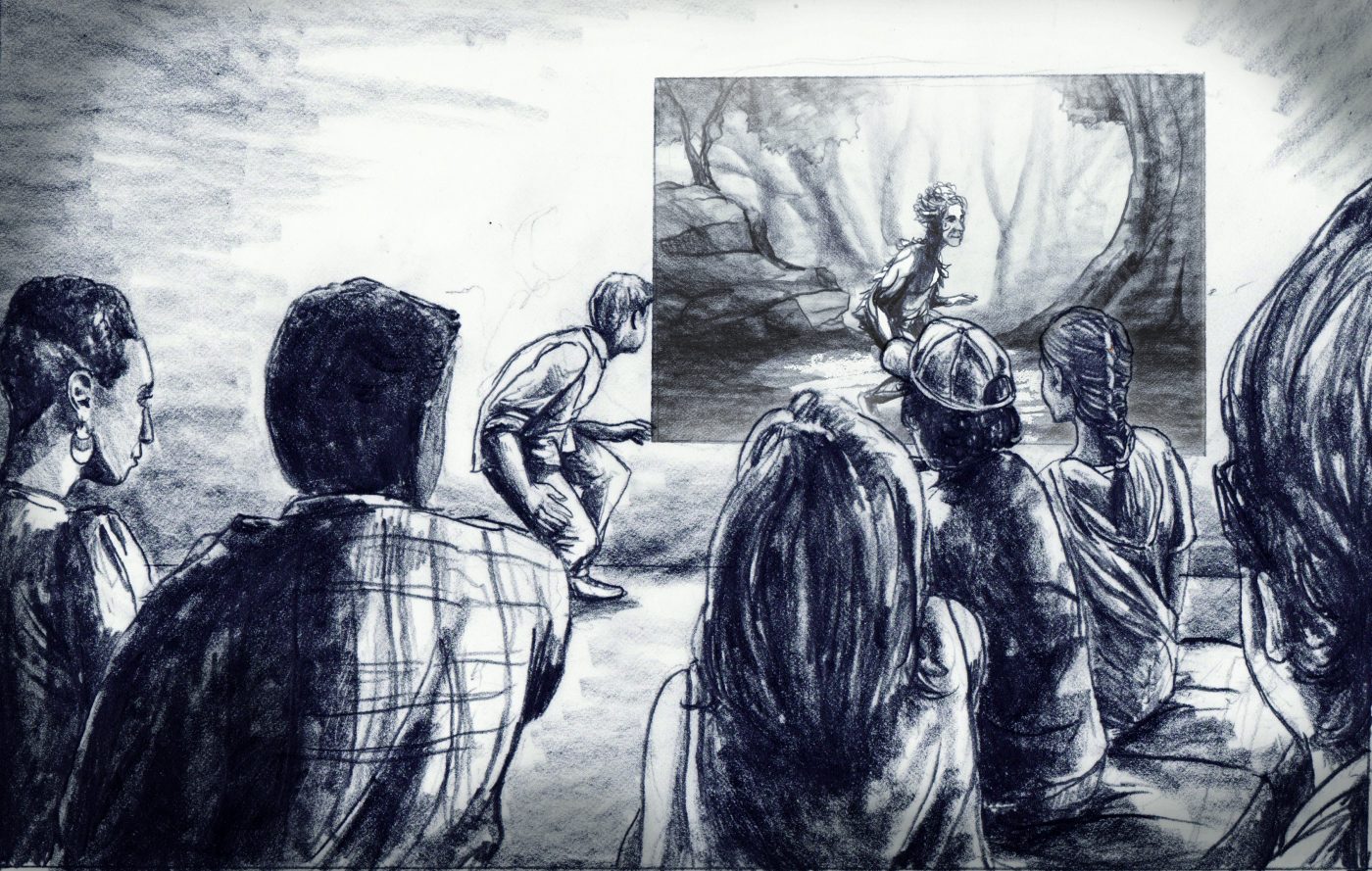
In some ways, our development of a motion-capture Shakespeare game was overdetermined. A few of our other research projects had already considered how the works of Shakespeare address questions of media and the materialities of communication, how they promiscuously accommodate different media contexts, and how they inspire and animate other domains of culture—including gaming communities, high-tech research laboratories, and scientific discourses.[45] To be sure, the works of Shakespeare have often wound up in the vanguard of new media forms, helping to confer cultural legitimacy and legibility to any number of communications technologies. As Michael Witmore, the director of the Folger Shakespeare Library, noted in an interview with BBC News about Play the Knave: “Pretty much every media form since the printed book has experimented with Shakespeare, whether that’s radio, television, film. Now we’ve got virtual reality, and it’s not surprising that one of the first places we go to see what this technology provides is to Shakespeare.”[46] This is not simply because Shakespeare’s central place in the literary canon continues to be reasserted and rearticulated, affirming the role of literature as a cultural institution even in the high-tech era.[47] Rather, it is because Shakespeare’s plays are figuration machines, making them remarkably adaptable to the particularities of any media regime and catalyzing revisions, remediations, and cavalier appropriations that address the prevailing order of things.[48] Even as new media forms come and go, Shakespeare seems to always be in fashion—always à la mode.
 In other ways, the invention of Play the Knave was serendipitous and opportunistic. In 2012, the ModLab joined a team of Canadian colleagues to create IMMERSe: The Interactive and Multi-Modal Experience Research Syndicate, a.k.a. the IMMERSe Network. This endeavor was spearheaded by Neil Randall, a professor of English and the director of the Games Institute at the University of Waterloo, and Karen Collins, then Canada Research Chair in Interactive Audio at the University of Waterloo and now a professor in the School of Information Technology at Carleton University. Running from 2012 to 2018, the IMMERSe Network was a consortium of five Canadian universities (University of Waterloo, Carleton University, Concordia University, McMaster University, and Ontario Tech University) and one US university (UC Davis), along with industrial partners and affiliations with several cultural heritage institutions.[49] Supported by a large grant from the Canadian Social Sciences and Humanities Research Council (SSHRC) and matching funds from the partner institutions, the IMMERSe Network focused on video games and their impacts in high-tech society. Our UC Davis ModLab team got involved with creating this consortium because Karen Collins came to UC Davis in the 2010–2011 academic year as a visiting scholar. Collins was a longtime friend of Michael Neff, a professor of computer science and cinema and digital media at UC Davis, and one of the founding members of the ModLab. As luck would have it, all’s well that ends well, and the wheel came full circle. When we joined the IMMERSe project, our fortunes changed. Until this time, the ModLab was an itinerant lab group, temporarily occupying whatever spaces on the UC Davis campus we could find on a given day for meetings and projects. But our involvement with the IMMERSe Network—and our success in securing external funding from SSHRC and other granting agencies—inspired the then dean of the UC Davis College of Letters and Science’s Division of Humanities, Arts, and Cultural Studies, Jessie Ann Owens, to offer us a permanent laboratory space. This space allocation was a massive, life-changing upgrade that immediately expanded our capacity to do collaborative work in the flesh.
In other ways, the invention of Play the Knave was serendipitous and opportunistic. In 2012, the ModLab joined a team of Canadian colleagues to create IMMERSe: The Interactive and Multi-Modal Experience Research Syndicate, a.k.a. the IMMERSe Network. This endeavor was spearheaded by Neil Randall, a professor of English and the director of the Games Institute at the University of Waterloo, and Karen Collins, then Canada Research Chair in Interactive Audio at the University of Waterloo and now a professor in the School of Information Technology at Carleton University. Running from 2012 to 2018, the IMMERSe Network was a consortium of five Canadian universities (University of Waterloo, Carleton University, Concordia University, McMaster University, and Ontario Tech University) and one US university (UC Davis), along with industrial partners and affiliations with several cultural heritage institutions.[49] Supported by a large grant from the Canadian Social Sciences and Humanities Research Council (SSHRC) and matching funds from the partner institutions, the IMMERSe Network focused on video games and their impacts in high-tech society. Our UC Davis ModLab team got involved with creating this consortium because Karen Collins came to UC Davis in the 2010–2011 academic year as a visiting scholar. Collins was a longtime friend of Michael Neff, a professor of computer science and cinema and digital media at UC Davis, and one of the founding members of the ModLab. As luck would have it, all’s well that ends well, and the wheel came full circle. When we joined the IMMERSe project, our fortunes changed. Until this time, the ModLab was an itinerant lab group, temporarily occupying whatever spaces on the UC Davis campus we could find on a given day for meetings and projects. But our involvement with the IMMERSe Network—and our success in securing external funding from SSHRC and other granting agencies—inspired the then dean of the UC Davis College of Letters and Science’s Division of Humanities, Arts, and Cultural Studies, Jessie Ann Owens, to offer us a permanent laboratory space. This space allocation was a massive, life-changing upgrade that immediately expanded our capacity to do collaborative work in the flesh.
Not long after the launch of IMMERSe, Neil Randall began conversations with the leadership team of the Stratford Festival—the largest repertory theater festival in North America, running annually from April to October in Stratford, Ontario—about the possibility of designing Shakespeare-themed video games to enhance the festival experience and to entice younger theatergoers with the allure of interactive media. Under the directorship of Anita Gaffney, the Stratford Festival had been actively expanding its profile in cyberspace, pushing social media content, creating smartphone apps, and developing an interactive website to court Shakespeare fans, old and new.[50] Among these digital outreach efforts, video games were front and center. As Gaffney noted at the time, “We want to use some of these great characteristics of gaming to engage people in theatre, to get them to know more about theatre, to get them excited about coming to Stratford and identifying the quality of things we have here.”[51]
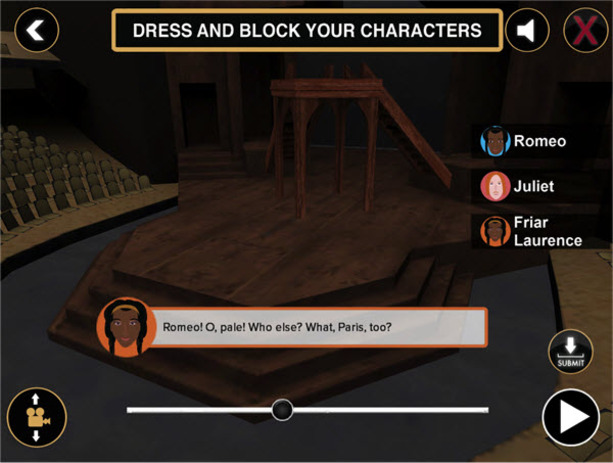
In 2012, under the auspices of IMMERSe, Jennifer Roberts-Smith, Shawn DeSouza-Coelho, Toby Malone, and Neil Randall at the University of Waterloo worked together with Andrew Matlock and Rani Lian at Industry Corporation in Ontario to prototype a mobile game app for the Stratford Festival. This game, Staging Shakespeare, allowed players to direct a production of Romeo and Juliet, choosing sets, props, and costumes, assigning a limited range of avatar movements, and picking vocal performances from a set of pre-recorded renditions by Festival actors. The game also had a “critic” function, allowing players to critique and rate productions directed by other players. Although it was a fascinating pilot experiment in theatrical game design, Staging Shakespeare remains in the prototype phase and, regretfully, the developers decided in the autumn of 2013 that it would never be released.[52] Nevertheless, as a prototype, it continues to provoke the imagination and inspire possible futures.
During one of Randall’s visits to UC Davis in 2013, we revisited the proposition of creating a game tailored to the Stratford Festival—a game that would complement the Festival’s reputation for adventurous interpretations of Shakespeare and further its commitment to popular education. Subsequently, over several weeks of meetings in the ModLab with the whole group, we assessed a variety of game genres that might address these values, and we mocked up some possible development routes.
Act II will describe that early ideation process in more detail, but for now we simply note that, ultimately, we chose to follow the approach taken by Staging Shakespeare and other theater-making games, recognizing the promise of such games to enskill audiences and teach theatrical competencies.[53] However, we also envisaged a significant twist.
From the beginning of the ModLab, we had been experimenting with VR and motion-sensing technologies for research applications in the sciences, the arts, and the digital humanities.[54] One strand of this work, spearheaded by Oliver Kreylos, involved hacking Kinect cameras, 3DTVs, and Oculus Rift and HTC Vive headsets to create low-cost, multi-user VR environments. In fact, one of our earliest ModLab projects, Going to the Movies in Paris in the 1930s (2010–2011), focused on the affordances of massively multiplayer online worlds and bespoke Vrui environments for showcasing cinema history and media archaeology.[55] Around the same time, some of our ModLab team members were also applying this research to mixed-reality art performances, such as Scoring Beckett (2014, dir. John Zibell), Glitchbody / Nanostalgia [1454–2015] (2015, dir. John Zibell and Guillermo Gómez-Peña), and Intangible Body (2016, dir. Emelie Mahdavian).
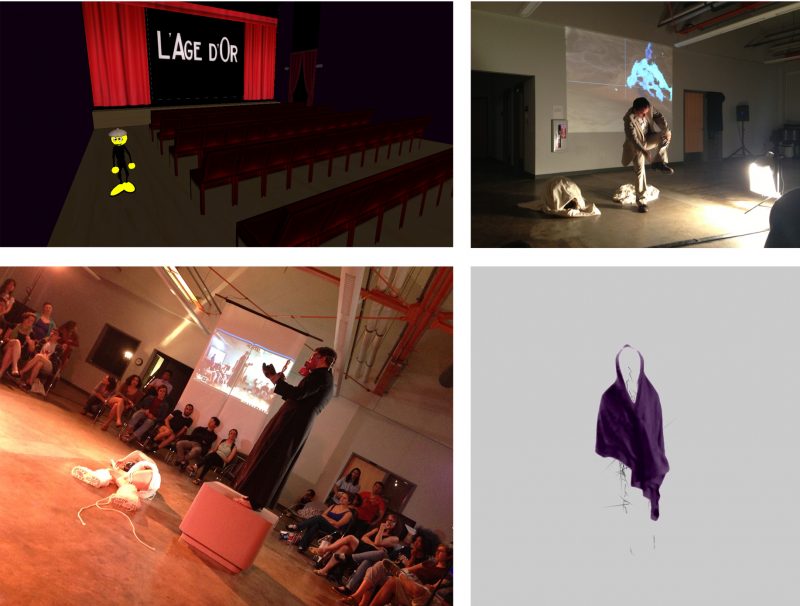
So, coming from this context, we proposed a motion-capture game to be installed in the lobby of the Stratford Festival Theater that would enable visitors to perform scenes from Shakespeare, either by themselves or with groups of friends, while waiting for a show to begin and during intermission. We suggested that, by highlighting key scenes, the game would help to focus attention on issues of interpretation, performance, and dramaturgy, insofar as players would be able to reflect on their own interpretive choices in comparison to those of the professional actors and designers of the Stratford Festival. Anita Gaffney, the Festival’s executive director, and Calvin Wood, the Festival’s director of marketing and digital branding from 2014 to 2016, responded enthusiastically to this idea. With the Festival’s blessing, we promptly began working on the game, aiming to have it ready for the 2015 Festival season. While there were many unexpected technical and conceptual challenges to solve along the way, the genesis of the game was informed by previous experiments: an instance of modification in practice, tactically adapting earlier work for a new context and a new purpose.
But in the course of development, it gradually became clear that Play the Knave was more than one game among many in our ModLab. As a device, a system, a high-tech apparatus for mixed-reality performances, and a Shakespeare simulator, it was also a symbol—even an allegory—for the ModLab itself and our research efforts. Cobbled, kludged, and hacked together from inherited cultural and technical resources, yet rendered more than the sum of its parts through the process of conjoining them, it instantiated the extent to which the ModLab is not just a laboratory but a collaboratory.
“As we greet modern friends withal” | It’s a Mod, Mod World
Over the years, our interdisciplinary collaborations became mutually transformative: all of us learning from each other, drawing upon the knowledge, techniques, and tools of other fields to address particular problems, and creating a genuinely transdisciplinary, postdisciplinary assemblage in the process—where, as the philosophers Gilles Deleuze and Félix Guattari would say, “the whole is itself produced alongside the parts, as a part apart.”[56] Even if we did not always recognize these transformations happening in the moment, they were happening tacitly, becoming embodied in our habits, our conversations, our friendships, and our ways of thinking, and changing our inherited rulesets to become another game entirely.
As we detail further in the next three acts, Play the Knave required us to assemble components of field-specific knowledge into a mutant chimera—a synthetic, hybrid project whose elements were as interesting to computer scientists and game designers as to scholars of literature and media. It called for close collaboration at every level: writing the code, designing the interface and the graphical elements, sampling and editing scenes from Shakespeare, morphing an archive of texts into a database readable by the software and playable by human users, and so on. In this regard, our work on the project typified the ways in which digital humanities labs and other hybrid research spaces often bring wildly different fields of practice into intimate contact, experimenting with the conditions of disciplinarity while also experimenting with the technical and cultural dimensions of computational media.[57]
But the completed game thematizes these issues even more vividly. When playing the game—moving the body, reading the scripted lines, trying to make the avatar image inhabit the simulated stage in a fitting or unfitting way—it becomes evident that players are engaged in a process of transformative collaboration, as well. Playing the game involves not only a collaboration with Shakespeare—rehearsing, interpreting, and often modifying, adapting, or rewriting the play script on the spot—but also a collaboration with the software and hardware of the game system.[58] Conspicuously, the Kinect camera—with all of its peculiar affordances and limitations—demands that players adapt their behaviors, denaturing their normal bodily articulations in order to get a legible performance to take place on screen. The Kinect responds to the players, and the software modulates the data from the Kinect and redeploys it for the visual benefit of the players, who then recompose themselves to better address the textual and graphical context of the Shakespearean performance they have chosen, and so on: a cybernetic feedback loop, in which all elements modify each other over time, at least for the duration of the game.
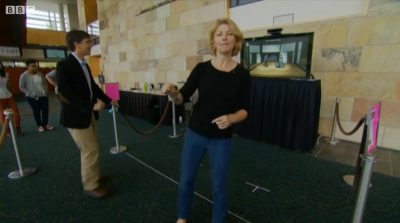
Moreover, when staging the game in physical spaces for people to play—first, in the ModLab itself, tested and retested by legions of student volunteers; second, at the Stratford Festival, experienced by thousands of theatergoers; and then, in many other locations around the world over the last eight years—we have noticed that even people who are not actively playing the game themselves but instead watching others play are also often intensely involved in the performance. Indeed, they are part of the game, reacting to the onscreen and offscreen actions in ways that likewise impact those actions: laughing, cheering, making interpretive comments or jokes, and so forth. As a spectator sport, Play the Knave expands the domain of play to include gamers and audiences alike, inspiring them to encourage, teach, and entertain each other. Additionally, as video recordings and images of these performances travel through various media channels—including social media platforms, newspaper reports from several different countries, and even a profile story broadcast globally on BBC News—the game involves, hails, and enfolds ever more far-flung audiences in vicarious play.[59]
Indeed, many of the teachers who have reached out to us over the years to use Play the Knave in their classrooms have first seen clips of it online, or watched others playing it in conferences and workshops. Some of these teachers, although excited to play the game with their students, have been apprehensive about hardware limitations—not only because Microsoft had discontinued the Kinect camera in 2017, but also because their schools did not have access to any gaming PCs with sufficiently powerful graphics cards. Attentive to this situation, we established a program of Play the Knave loaner kits in 2017, supported by generous gifts from Margaret Bowles, an alumna of UC Davis and a lifelong educator, and also by a grant from the UC Davis Academic Senate Committee on Research. (Each of these loaner kits includes an Alienware PC pre-installed with Play the Knave, a Kinect camera, the Kinect Windows adapter, detailed instructions for setting up the system, and links to online lesson plans geared toward secondary school students; in the early phases of implementation, Bloom and/or a UC Davis student intern also traveled with the kits to provide in-person educational support.) When taking the game into their classrooms, teachers often modify things for their own pedagogical goals, to address the needs of their students.

To be sure, the software is designed to encourage experimentation. As we discuss further in Act II, the game includes functions for uploading new scripts into the game—facilitated by our online Scriptmaker application—as well as decoupling from scripts entirely to play improvisational theater games or to develop unique machinima creations. We have also released the software code under an open-source license, allowing anyone to evolve the game and add functionalities if they so choose. As the game is put to different uses in classrooms, museums, libraries, and other places, new institutional connections and partnerships also emerge. These partnerships likewise feed back into the game development pipeline, opening up trajectories for further experiments, innovative lesson plans, and software features yet to come.[60]
In other words, Play the Knave embodies collaboration all the way down: collaboration of the humanities, arts, and sciences; collaboration of technologies and bodies; collaboration of physical phenomena (optics, acoustics, osteokinematics) and computational data structures; collaboration of performers and audiences; collaboration of authors and readers, even long after the death of the author; and more, much more. That this ensemble of collaborative interactions can best be summed up under the name of play is attested by Shakespeare himself, whose works frequently insist upon the theatricality of everyday life, addressing the networks of human and nonhuman agencies whose dramatic interactions make up the ongoing performance of the world as such.[61] If Shakespeare tells us in As You Like It that “all the world’s a stage” (2.7.146), it is because everyone, nay, everything is an actor, and actors are always putting on roles, clowning around, rehearsing scripts or rewriting them on the spot—always feigning, like Shakespeare’s Rosalind, to “play the knave” (3.2.300).
Our game, Play the Knave, entices users to goof around with Shakespeare while fooling around with the game system, cavalierly exploiting its designed features and its technical quirks, and then seeing what happens. To play the knave means, among other things, to experiment: gaining knowledge and learning the rules precisely by bending the rules, finding the limits, thwarting convention, speculating otherwise, and gaming the game. Yes, you can put on a performance of Coriolanus with robots! And that’s just the beginning—the threshold of other futures, the horizon of brave new worlds.
On vicarious play and the ways in which audiences also become players, see Bloom, Gaming the Stage; and Bloom et al., “‘A whole theater of others.’” For some examples of the media coverage that has helped to disseminate vicarious play experiences of Play the Knave, see O’Brien, “Re-imagining Shakespeare’s Plays in Virtual Reality Game”; Trainor, “Experience Shakespeare in Video Game Form with Play the Knave”; UC Davis College of Letters and Science, “Learning the Bard by Playing the Knave”; Koenig, “What ‘Shakespeare Karaoke’ Teaches About the Virtual Reality Future”; and Ardis, “All the World’s a (Virtual) Stage.”
Latour and Woolgar, Laboratory Life.
See Barthes, “The Brain of Einstein”; Haraway, “Situated Knowledges”; Keller, Secrets of Life, Secrets of Death; Schiebinger, The Mind Has No Sex?; Lawrence and Shapin, eds., Science Incarnate; and Mialet, Hawking Incorporated.
See Bazerman, Shaping Written Knowledge; Shapin and Schaffer, Leviathan and the Air-Pump; and Haraway, Modest_Witness@Second_Millennium.FemaleMan©_Meets_OncoMouse™.
Traweek, Beamtimes and Lifetimes; and Hilgartner, Science on Stage.
See Shapin and Schaffer, Leviathan and the Air-Pump; Canaday, The Nuclear Muse; Blair, The Theater of Nature; Sawday, The Body Emblazoned; Case, Performing Science and the Virtual; M. Willis, ed., Staging Science; Gayken, Devices of Curiosity; Curtis, The Shape of Spectatorship; Shepherd-Barr, Science on Stage; Goodall, Performance and Evolution in the Age of Darwin; Pearl, About Faces; Kirby, Lab Coats in Hollywood; and Halpin, Contemporary Physics Plays.
Myers, Rendering Life Molecular; Barad, Meeting the Universe Halfway; Collins, Gravity’s Kiss; Keller, A Feeling for the Organism; Milburn, Mondo Nano; and Ghosh, The Virus Touch. On the manner in which performed bodily movement can condition “perceptual habituation” to unfamiliar, uncanny, or disorienting forms—whether poetic or scientific—see Chaganti, Strange Footing.
See Collins, “The TEA Set”; and Munns, A Single Sky.
Polanyi, Personal Knowledge; and Polanyi, The Tacit Dimension.
Latour, Science in Action.
See Shapin, “Pump and Circumstance”; Shapin and Schaffer, Leviathan and the Air-Pump; Myers, Writing Biology; Dear, ed., The Literary Structure of Scientific Argument; and Gross, Starring the Text.
See Beer, Darwin’s Plots; Haraway, Primate Visions; Serres, “Literature and the Exact Sciences”; Martin, “The Egg and the Sperm:”; Canaday, The Nuclear Muse; Squier, Liminal Lives; Otis, Müller’s Lab; Milburn, Nanovision; Larson, Metaphors for Environmental Sustainability; and Campos, Radium and the Secret of Life.
See Rheinberger, “Scrips and Scribbles”; Klein, Experiments, Models, Paper Tools; Kaiser, Drawing Theories Apart”; and Stevens, Life out of Sequence.
See Lenoir, ed., Inscribing Science; Rheinberger, An Epistemology of the Concrete; and Brain, The Pulse of Modernism.
See Turner, “Scientific Toys”; Keene, “‘Every Boy & Girl a Scientist’”; Gee, “Amusement Chests and Portable Laboratories”; Al-Gailani, “Magic, Science and Masculinity”; Gauvin, “Playing with Quantum Toys”; Gauvin, “The Next Level of Play”; Nguyen, The Digital Is Kid Stuff; and Alvis, Building Blocks.
Pickering, The Mangle of Practice, 21.
See Galison, Image and Logic; Biagioli, Galileo’s Instruments of Credit; M. Jones, Reckoning with Matter; and Gauvin, Instruments of Knowledge.
See Francoeur, “The Forgotten Tool”; Laszlo, “Playing with Molecular Models”; de Chadarevian and Hopwood, eds. Models; Kohler, Lords of the Fly; Rader, Making Mice; Toon, Models as Make-Believe; Ensmenger, “Is Chess the Drosophila of Artificial Intelligence?”; and Gaboury, Image Objects. For an example of discovery through playing with toy models, see Watson, The Double Helix.
See Star and Griesemer, “Institutional Ecology, ‘Translations’ and Boundary Objects”; Haraway, Primate Visions; Tiffany, Toy Medium; Rheinberger, An Epistemology of the Concrete; N. Brown, The Limits of Fabrication; and Wylie, Preparing Dinosaurs. For an example of this kind of material play, see Colbert and Smalley, “Fullerene Tinker Toys.”
Jacob, The Statue Within, 9.
Shakespeare, The Tempest, 4.1.173.
Huizinga, Homo Ludens, 34.
Jacob, The Statue Within, 8.
Myers and Dumit, “Haptic Creativity and the Mid-Embodiments of Experimental Life.”
On the so-called scientific method and the disciplining of play in the development of the modern inductive sciences, see Findlen, “Between Carnival and Lent”; Findlen, “Jokes of Nature and Jokes of Knowledge”; and Cowles, The Scientific Method. As opposed to the lofty, public-facing ideals of the scientific method, behind laboratory doors, actual scientific research instead more typically sidesteps and games the rules of method—and in doing so, it thrives; see Feyerabend, Against Method; and Brooks, Free Radicals. On the resemblance of normal science to puzzle-solving and game-playing, with or without established rules, see Kuhn, The Structure of Scientific Revolutions, 35–42. On the knowledge-producing capacities of play, see Milburn, Mondo Nano; and Adamowski, “Productive Indeterminacy.”
In this regard, laboratories and experimental knowledge are like other forms of cultural production. As Roland Barthes famously observed, “The text is a tissue of quotations drawn from the innumerable centres of culture”; see Barthes, “The Death of the Author,” 146. Michel de Certeau argued this point more expansively: “Everyday life invents itself by poaching in countless ways on the property of others”; see de Certeau, The Practice of Everyday Life, xii. On ways in which scientific practices and discourses appropriate popular culture, and vice versa, see Penley, NASA/TREK.
Milburn, “Modifiable Futures”; and Wershler, Emerson, and Parikka, The Lab Book.
Shakespeare, The Tempest, 4.1.163.
Shakespeare, Hamlet, 1.1.24: “A mote it is to trouble the mind’s eye.” On the transformative powers of laboratories, see Latour, The Pasteurization of France; and Latour, “Give Me a Laboratory and I Will Raise the World.”
Latour, Reassembling the Social, 46. Latour is here thinking with Goffman, The Presentation of Self in Everyday Life.
Barad, Meeting the Universe Halfway, 149.
Jacob, The Statue Within, 9.
Michael Whitmore, interviewed in Jane O’Brien, “Re-imagining Shakespeare’s Plays in Virtual Reality Game.” For some examples of Shakespeare’s role in media history and media ecologies, see Ball, Shakespeare on Silent Film; Anderegg, Orson Welles, Shakespeare, and Popular Culture; Buchanan, “Shakespeare and the Magic Lantern”; and O’Neill, ed., Broadcast Your Shakespeare. On Shakespeare in games and playable media more specifically, see Donaldson, “Game Space/Tragic Space”; Rowe, “Crowd-Sourcing Shakespeare”; Osborne, “iShakespeare”; Harrison and Lutz, “South of Elsinore”; Misak and LaGrandeur, “Perchance to Read”; and Bishop, Bloom, and Lin, eds., Games and Theatre in Shakespeare’s England.
Turner, Shakespeare’'s Double Helix; Yates, “Accidental Shakespeare”; Harris, Untimely Matter in the Time of Shakespeare; and Werth, ed., The Shakespearean International Yearbook 15.
See Balsamo, Designing Culture; Davidson and Savonick, “Digital Humanities”; Deegan and McCarty, eds., Collaborative Research in the Digital Humanities; Drucker, SpecLab; Hayles, How We Think; Jones, The Emergence of the Digital Humanities; King, Networked Reenactments; Klein, Interdisciplining Digital Humanities; Lane, The Big Humanities; McPherson, Feminist in a Software Lab; O’Gorman, Necromedia; and Svensson, Big Digital Humanities. For a broader history and theory of hybrid labs and their epistemic features, see Wershler, Emerson, and Parikka, The Lab Book.
See Balsamo, Designing Culture; Davidson and Savonick, “Digital Humanities”; Deegan and McCarty, eds., Collaborative Research in the Digital Humanities; Drucker, SpecLab; Hayles, How We Think; Jones, The Emergence of the Digital Humanities; King, Networked Reenactments; Klein, Interdisciplining Digital Humanities; Lane, The Big Humanities; McPherson, Feminist in a Software Lab; O’Gorman, Necromedia; and Svensson, Big Digital Humanities. For a broader history and theory of hybrid labs and their epistemic features, see Wershler, Emerson, and Parikka, The Lab Book.
See Balsamo, Designing Culture; Davidson and Savonick, “Digital Humanities”; Deegan and McCarty, eds., Collaborative Research in the Digital Humanities; Drucker, SpecLab; Hayles, How We Think; Jones, The Emergence of the Digital Humanities; King, Networked Reenactments; Klein, Interdisciplining Digital Humanities; Lane, The Big Humanities; McPherson, Feminist in a Software Lab; O’Gorman, Necromedia; and Svensson, Big Digital Humanities. For a broader history and theory of hybrid labs and their epistemic features, see Wershler, Emerson, and Parikka, The Lab Book.
Deleuze and Guattari, Anti-Oedipus, p. 286. On the transformative reclustering of disciplinary configurations around particular problems and challenges, whose solutions do not require the homogenization of two or more disciplines into new synthetic fields or perfectly convergent goals, but which instead afford sustainable cross-disciplinary relationships and symbiotic assemblages, see Biagioli, “Postdisciplinary Liaisons.” On universities as places that routinely compose and decompose disciplines by facilitating the conditions and circumstances of collaboration, see Marx and Cooper, Media U.
For an overview, see IMMERSe: The Research Network for Video Game Immersion, August 21, 2019, http://immerse.network.
For an overview, see IMMERSe: The Research Network for Video Game Immersion, August 21, 2019, http://immerse.network.
For an overview, see IMMERSe: The Research Network for Video Game Immersion, August 21, 2019, http://immerse.network.
For an overview, see IMMERSe: The Research Network for Video Game Immersion, August 21, 2019, http://immerse.network.
For an overview, see IMMERSe: The Research Network for Video Game Immersion, August 21, 2019, http://immerse.network.
For an overview, see IMMERSe: The Research Network for Video Game Immersion, August 21, 2019, http://immerse.network.
For an overview, see IMMERSe: The Research Network for Video Game Immersion, August 21, 2019, http://immerse.network.
Michael Whitmore, interviewed in Jane O’Brien, “Re-imagining Shakespeare’s Plays in Virtual Reality Game.” For some examples of Shakespeare’s role in media history and media ecologies, see Ball, Shakespeare on Silent Film; Anderegg, Orson Welles, Shakespeare, and Popular Culture; Buchanan, “Shakespeare and the Magic Lantern”; and O’Neill, ed., Broadcast Your Shakespeare. On Shakespeare in games and playable media more specifically, see Donaldson, “Game Space/Tragic Space”; Rowe, “Crowd-Sourcing Shakespeare”; Osborne, “iShakespeare”; Harrison and Lutz, “South of Elsinore”; Misak and LaGrandeur, “Perchance to Read”; and Bishop, Bloom, and Lin, eds., Games and Theatre in Shakespeare’s England.
See Crease, The Play of Nature.
Michael Whitmore, interviewed in Jane O’Brien, “Re-imagining Shakespeare’s Plays in Virtual Reality Game.” For some examples of Shakespeare’s role in media history and media ecologies, see Ball, Shakespeare on Silent Film; Anderegg, Orson Welles, Shakespeare, and Popular Culture; Buchanan, “Shakespeare and the Magic Lantern”; and O’Neill, ed., Broadcast Your Shakespeare. On Shakespeare in games and playable media more specifically, see Donaldson, “Game Space/Tragic Space”; Rowe, “Crowd-Sourcing Shakespeare”; Osborne, “iShakespeare”; Harrison and Lutz, “South of Elsinore”; Misak and LaGrandeur, “Perchance to Read”; and Bishop, Bloom, and Lin, eds., Games and Theatre in Shakespeare’s England.
Bloom, Voice in Motion; Bloom, Bosman, and West, “Ophelia’s Intertheatricality”; and Milburn, Mondo Nano.
Dumit, “Game Design as STS Research”; Steele, “The Maker Turn in Classroom Games”; Phillips, “Gaming”; and Nguyen and Phillips, “GameCamp! Procedural Thinking Workshop.” On the history of games as models of systems, see Pizelo, “Games and the Rise of Systems Thinking.”
Sawyer Kemp, “Escape Rooms and the Seductive Ubiquity of Capture.” While a Ph.D. student in English at UC Davis and a member of the ModLab, Kemp also worked for two years as an operator and game designer at Escape Sacramento in Sacramento, California. Around the same time, in 2017, Marty Weis and Kim Weis launched Game the Room, an escape room based in Sonoma, California; it closed in 2020 due to the COVID-19 pandemic, which was sadly devastating for the whole escape room industry. On his founding of Game the Room following his Ph.D. at UC Davis and his MBA at Sonoma State University, see Weis, “Marty Weis ’15—Game the Room.”
Weiss, “Assassin’s Creed and the Fantasy of Repetition”; and Dumit, “Lagging Realities.”
Lauteria, “Envisioning Queer Game Studies”; Phillips, “‘Welcome to My Fantasy Zone’”; and Phillips, “(Queer) Algorithmic Ecology.”
Ravetto-Biagioli, Digital Uncanny; Fedorova, Tactics of Interfacing; and Fallon, “Streams of the Self.”
Balds, “Beckett’s Calculus of the Subject”; Balds, “Krapp’s Last Tape and Breath as Algorithmic Performances”; and Zibell, “Scoring Beckett | 5C0r1n9 83Cq377.”
Nguyen, The Digital Is Kid Stuff; Carroll, “Geek Temporalities and the Spirit of Capital”; and Carroll, “The Lifecycle of Software Engineers.”
Milburn, Respawn; Phillips, “Shooting to Kill”; and Phillips, Gamer Trouble.
Milburn and Wills, “Citizens of the Future”; Milburn et al., “Join the Fold”; Miller et al., “Wrapped in Story”; and Wills, “Corporate Agriculture and the Exploitation of Life in Portal 2.”
Buse, “The Working Planetologist”; Buse, “Genesis Effects”; Dhaliwal, “The Cyber-Homunculus”; Milburn, “Ahead of Time”; and Wills, “‘La vie impossible.’” For overviews and interviews about the various collaboratory research projects in the ModLab, see Basit, “The UC Davis ModLab”; and Day, “ModLab.”
See Boluk and LeMieux, Metagaming; Milburn, Respawn; Jagoda, Experimental Games; Ask, “The Value of Calculations”; Mitchell, Ludopolitics; and Hua and Raley, “Playing with Unicorns.” See also Clarke, Profiles of the Future, 21: “The only way of discovering the limits of the possible is to venture a little way past them into the impossible.”
On the ways in which laboratories function as future-oriented systems that animate a play of differences, indefinitely deferring presence and casting the present beyond itself, see Rheinberger, Toward a History of Epistemic Things; and Doyle, On Beyond Living. Both Rheinberger and Doyle grapple with Jacob’s temporal gymnastics and his sense that, in the laboratory, as Shakespeare might say, “time is out of joint” (Hamlet, 1.4.210).
